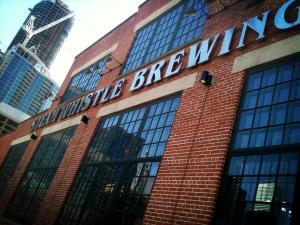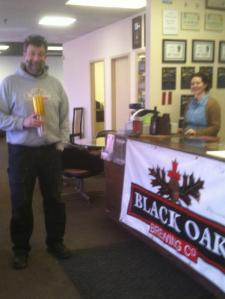I am happy to report that 50 years after entering primary school, I still feel a frisson of glee upon hearing “field trip”. And today was no ordinary field trip, being “The Day of Three Breweries”–a visit to three breweries in three hours. (Or at least that was the original plan. As Field Marshall Moltke the Elder is reported to have said, “No plan for battle survives contact with the enemy.”)

Steam Whistle, showcase brewery in downtown Toironto
First up was Steam Whistle. As previously mentioned in this blog, Steam Whistle was formed in 2000 by three guys who had been working for Upper Canada Brewing and were subsequently fired (along with everyone else in the company) when it was taken over by Sleeman.
(Full disclosure: When I tasted a bottle of Upper Canada Dark in 1985, the heavens parted, the glory shone down and the Choir Celestial sang. Every beer before that day had been bland and lifeless. It was like seeing in colour for the first time. O, how I wept bitter tears when Upper Canada was taken over by Sleeman. But I digress…)
We had the pleasure of talking to Greg & Sybil Taylor–Greg is one of the original “3 Fired Guys”; his wife Sybil actually worked at Upper Canada longer than Greg, and is now the Director of Communications at Steam Whistle.
What they did 13 years ago now seems like a simple recipe for success–form a company that only makes one beer, then market the heck out of it. This year, Steam Whistle will likely produce about 70,000 hL of their single label, Steam Whistle Pilsner. However, it wasn’t a straight line from then to now. It took two years just to develop a business plan for the new brewery. Once opened, there were a series of problems, crises and emergencies that threatened the very existence of the brewery. Equipment that was supposed to last a decade gave out after two years. The rise of craft breweries in Ontario also coincided with the rising popularity of good quality but cheap imported pilsners from Germany and Eastern Europe. And the large national breweries were no friends of the craft industry either. In Greg’s words, the macros have attempted to drive new breweries out of business with the philosophy of “drown them while they’re young.”
However, Steam Whistle has survived and prospered, likely due to their positive attitude towards employees–the company has won several awards for positive management practices such as flexible work hours, profit sharing, employee share purchase plans and trips for long service employees. With over 160 employees today, Steam Whistle’s biggest day-to-day challenge is human resources management–exactly what we have been hearing in our Human Resources classes. Sybil also mentioned the importance of excellent accounting software to keep track of inventory and taxes. And Greg talked about the camaraderie in the craft industry right now, the feeling of esprit de corps and cooperation among the various small breweries.
During Q & A, I asked about the reasoning behind the apparent move from their iconic green glass bottle to cans. Don’t worry, the bottles will still be around (in Ontario at least). It turns out that apparently cans sell better than bottles out in Alberta and B.C., where Steam Whistle is starting to gain a foothold, hence the move to package some of their product in cans.
Time for a tour. We were given a beer–yay!–and headed out on a tour led by a guide who was used to answering questions from the general public. Alas, she was somewhat flustered by questions about external calandria, hopping systems, and decoction mashes. Luckily a member of the on-shift brew team happened by to help her out.

Ken & Sonja await us (with beer!) at Black Oak
On to our next brewery. No wait, I’m lying. During our Steam Whistle tour, the bus developed a mechanical issue, and we had to wait nearly an hour for a replacement bus to take us to our second stop, Black Oak Brewing.
I have a confession to make: Black Oak is the brewery that employed me during the summer time. (The reason I didn’t name Black Oak is that when I was writing about my summer job, I didn’t want to focus on where I was working, but rather what I was doing. But I digress…)
There are several similarities between Black Oak and Steam Whistle–both were opened in 2000, and both have a small number of labels–Steam Whistle, of course, only has one beer, while Black Oak for many years only had two–a Pale Ale and a Nut Brown Ale. But where Steam Whistle set out to become a “showcase” brewery, moving into an old Canadian National Rail locomotive roundhouse beside the Skydome, where they now welcome thousands of visitors a year and employ 160 people, Black Oak set up shop in an industrial mall in Oakville, later moved to another industrial mall in southwest Toronto, and stayed relatively small, with only 5 people on staff. Several years ago, Black Oak jumped on the seasonal wagon, and now produce several each year in addition to their two flagship brands. They have also recently started packaging a portion of their beer in 650 mL bottles, again a trend in craft brewing. In addition, Black Oak is also the place where a number of contract brewers make their product, including Cheshire Valley, Radical Road, Snowman and Sawdust City.

The Bouncing Bomb, Trafalgar’s brewpub
Back on the bus for our final destination, Trafalgar Brewing. Like Black Oak, Trafalgar started in an industrial mall on the west side of Oakville, then picked up and moved a few years later… to the east side of Oakville. Then they reversed course and came back to the west side of town. Like Black Oak, Trafalgar has a very small staff, and a similar-sized brewhouse, but whereas Black Oak’s equipment is in a very large warehouse, Trafalgar’s building is small, and feels a bit cramped. Unlike Black Oak and Steam Whistle, Trafalgar has always made a lot of different beers, and also moved into mead production a few years ago.
Trafalgar also has a brewpub , the Bouncing Bomb. Needless to say, that is where we gathered at the end of the day.



